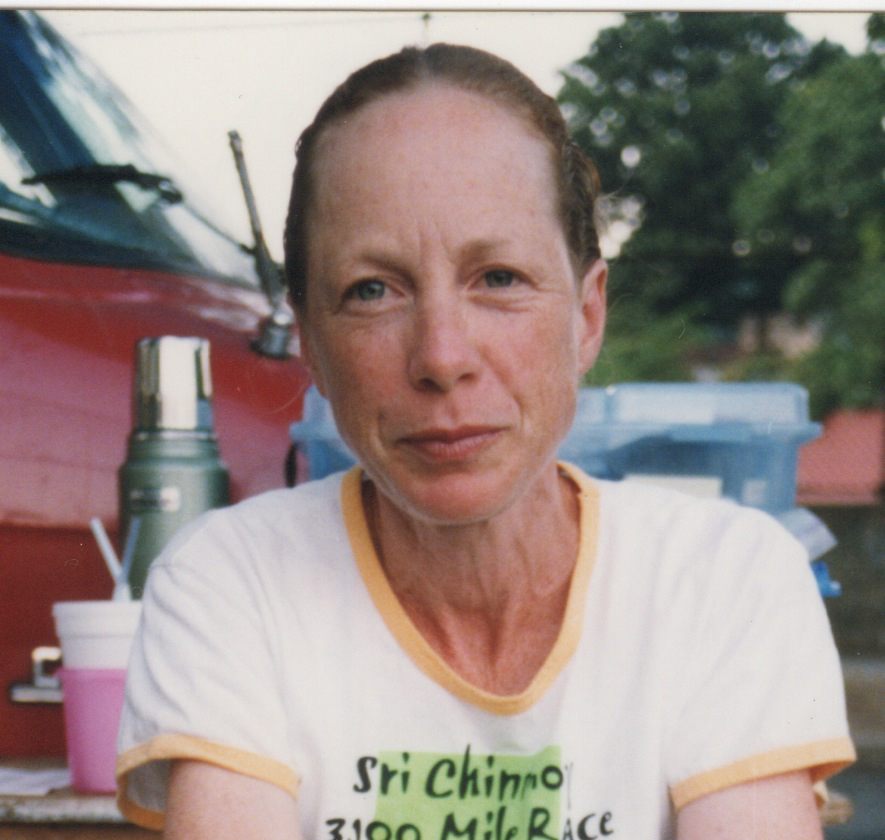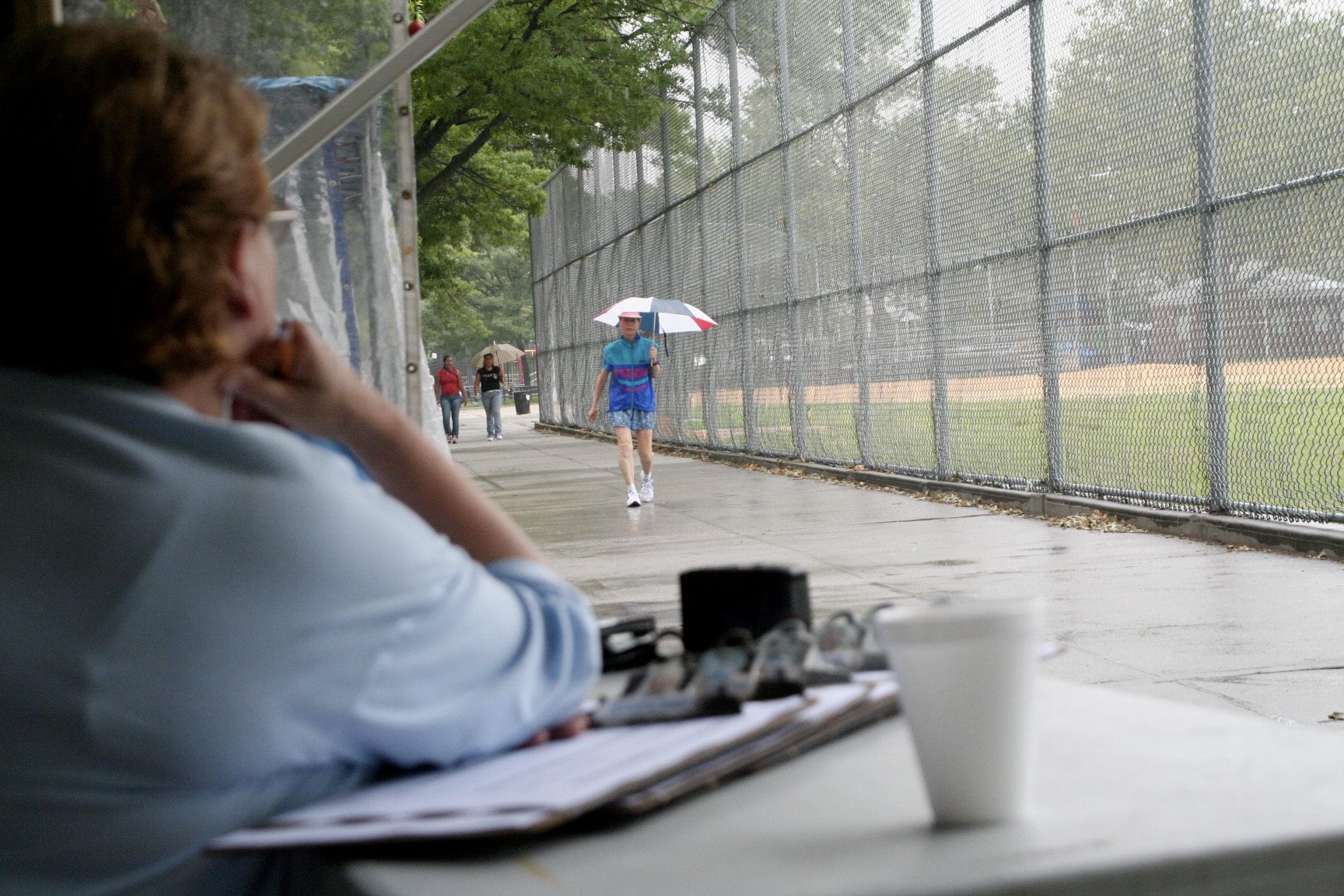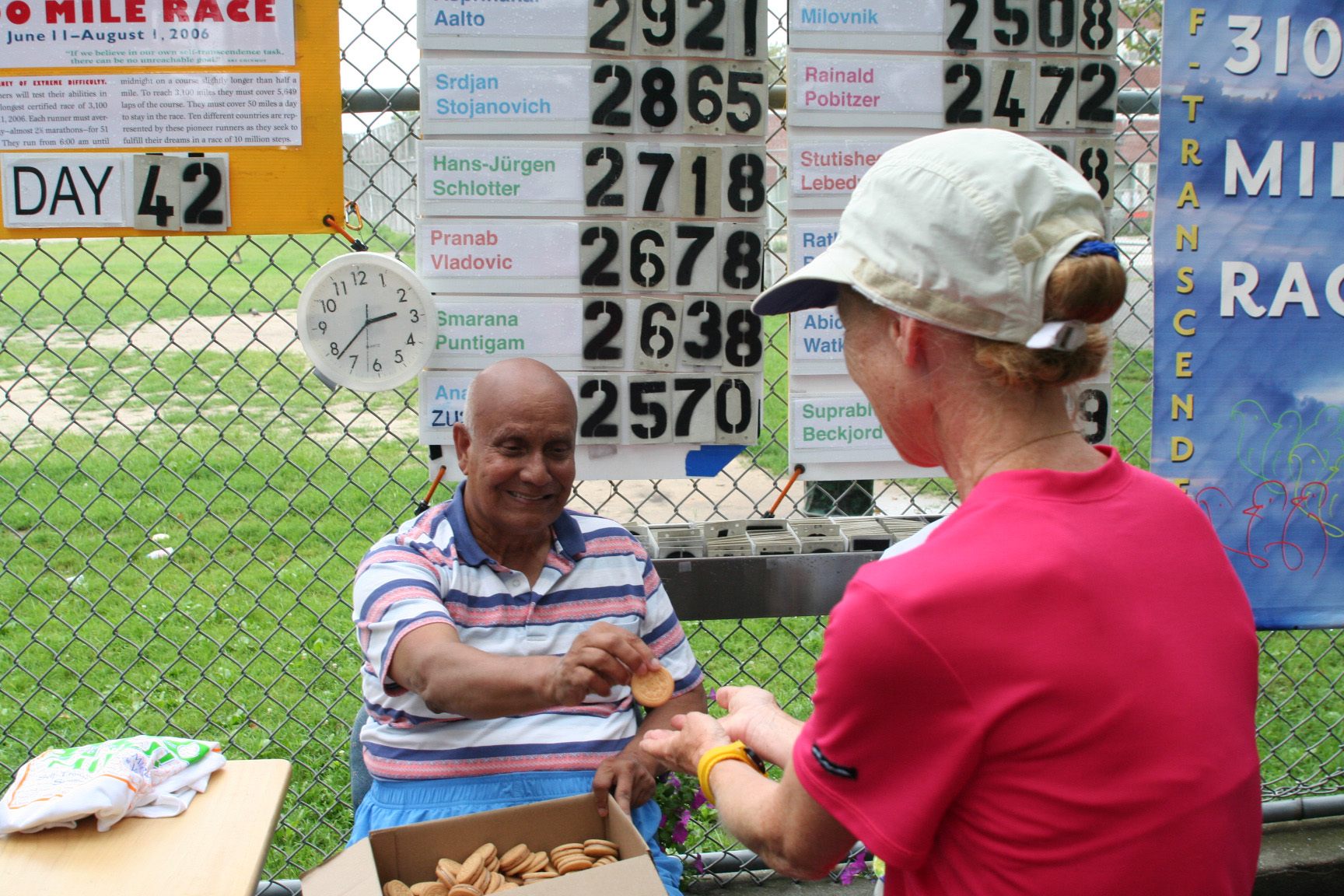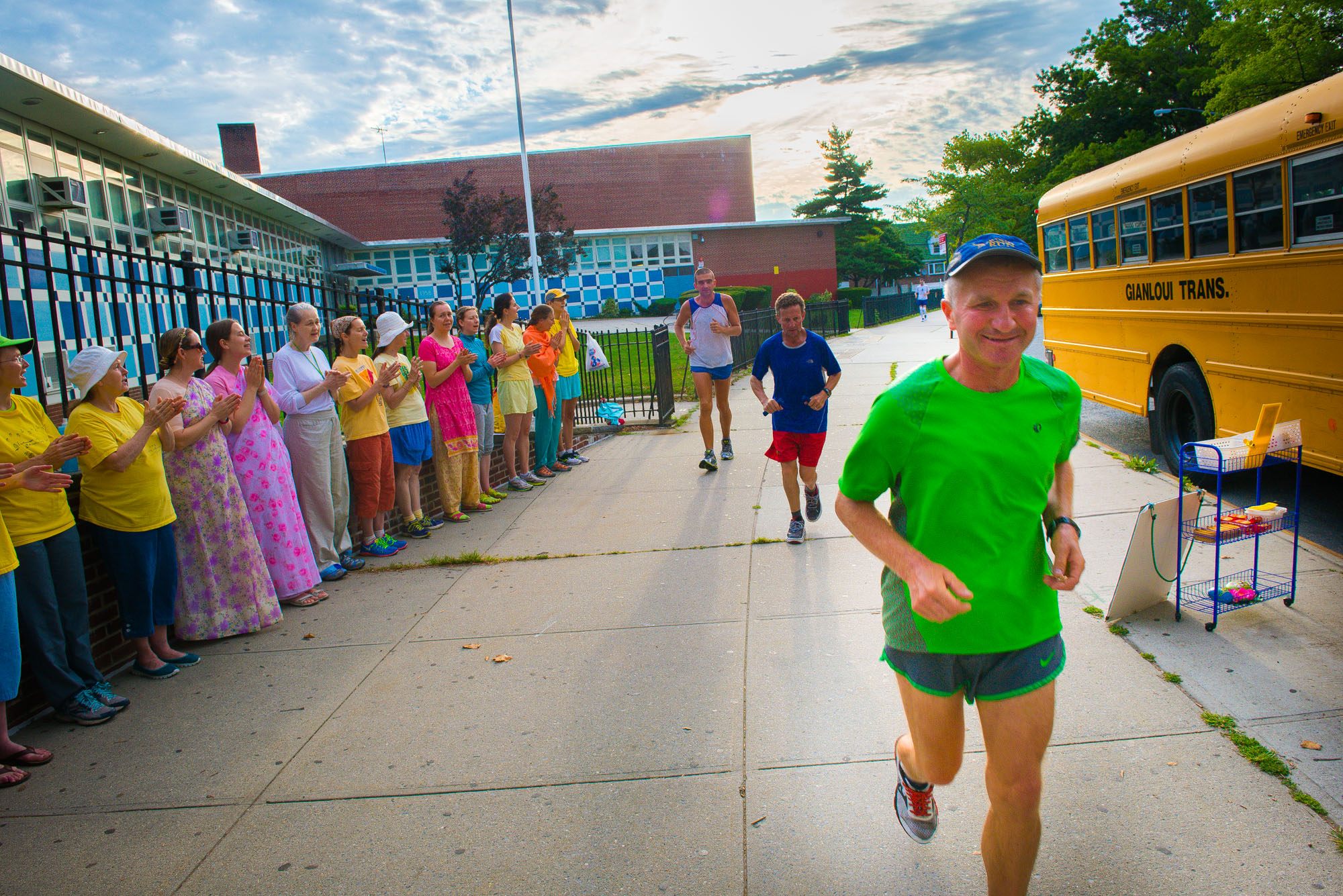America’s Least Likely Ultramarathoner Is Also One Of Its Best
Over her 23-year career, Suprabha Beckjord raced enough miles to circle the globe twice.

Suprabha Beckjord, on Day 43 of 2003’s 3100-mile race. (Photo: Sri Chinmoy Marathon Team)
Sure, she looks patient enough, smiling over the cash register. Maybe she’s got an extra bounce in her step as she helps someone pick out a greeting card. But customers at the Transcendence-Perfection-Bliss of the Beyond gift shop in Washington, D.C. likely don’t realize that Suprabha Beckjord, the 60-year-old woman standing behind the counter, isn’t just the store’s helpful proprietor—she’s one of the greatest endurance athletes the world has ever seen.
The word “ultramarathoner” conjures a certain set of images—wiry, spandex-clad self-punishers, fresh off months or years of physical training, pushing themselves through a desert or across a mountain range. Beckjord doesn’t look like that. She has a broad, shy smile scaffolded by laugh lines. Her voice is lilting and quiet, less like someone who regularly puts herself through shattering tests of endurance and more like your nicest aunt.
But every June from 1997 through 2009, Beckjord gave her store keys to her employees, packed up a dozen pairs of running shoes, and headed to Jamaica, Queens to run for eight weeks straight. She is one of a few dozen people in the world to have completed the Self-Transcendence 3100-Mile Race—a grueling endeavor that sees participants jogging at least 50 miles per day, 6 a.m. to midnight. And she did it 13 times.

Beckjord with her running umbrella in 2006. (Photo: srichinmoyultraphoto.com)
Like most of the competitors in the 3100-Mile Race, Beckjord came to running through Sri Chinmoy, an Indian spiritual leader who brought his particular form of endurance-inflected meditation from India to Queens in 1964. Chinmoy’s principles are unsurprising—mindfulness, openness, prayer—but his practices, which follow a kind of “more is more” philosophy, are somewhat unique. Your average guru might write a dozen books; during his lifetime, his disciples say, Chinmoy penned over a thousand, along with millions of paintings, and tens of thousands of short poems and songs. He personally rechristened each of his disciples, which, by the time he died in 2007, numbered about 7,000. (Suprabha Beckjord was born “Amy,” and Chinmoy even renamed her store, which used to be called “Visions of Beauty.”)
Beckjord began meditating at a Sri Chinmoy Centre when she was 24, fresh out of a college art program and drawn in by Chinmoy’s paintings, which she describes as “full of love and beauty.” Chinmoy also encouraged athleticism in his followers, and in the early 1980s, Beckjord found herself signing up for one of his “Inspiration Marathons,” generally held in the dead of winter. “It was a very windy day, quite cold, in Vermont,” she says. “It took me five hours. After that, I wasn’t really thinking ‘Oh boy, I have to do this more often.’”
Many runners pummeled by their first marathon might dial it down again, running shorter distances until they are ready to work their way back to 26.2. Instead, Beckjord dialed it up—largely thanks to Chinmoy’s race lengths, which were getting exponentially more intense. First, there was the 47-mile run, inaugurated on the guru’s 47th birthday and held annually thereafter. Beckjord ran that a few times. Then in 1986, Chinmoy, newly into weight training, claimed to have lifted 200 pounds with one arm, inspiring a massive celebration in Queens.

Sri Chinmoy hands Beckjord a cookie, 42 days into 2006’s race. (Photo: srichinmoyultraphoto.com)
“While I was there I kept hearing about a 200-mile run,” Beckjord says. “I finally asked someone, can anybody just sign up to do this?” The race lasted for four days and nights, the runners tracing a loop in Flushing Meadow Park. She finished first out of the women and second overall, and more importantly, she caught the bug. “I loved it,” says Beckjord. “Running all night, seeing the sun rise—I mean, who ever heard of that!”
The races proliferated, and kept lengthening—a seven-day all-you-can-run, a 1,000-miler, a 1,300-miler. Beckjord did them all, grabbing up world records that hadn’t even existed before. In 1996, the group held a 2700-mile run. “At the end of the race, Sri Chinmoy announced that we would all be welcome the next year, but it would be 400 miles longer,” remembers Beckjord. “And that was the birth of the 3,100 mile race.”
Thirty-one-hundred miles is a mind-boggling distance. It’s the distance between Portland, Maine and San Diego, and fully twice the length of a Boston to Miami jaunt. No other reliably held ultramarathons even come close—the vast majority clock in under 100, and even the famously intense Marathon des Sables, which has killed three people, is a paltry 156 (although, to be fair, it is across the Sahara). Even crazier than the length, though, is the racecourse. If you were actually to run from Boston to Miami and back again, at least you’d get to see the changing coastline. Self-Transcendence racers are treated, over and over, to the same sweaty half-mile block of Queens.

Runners get encouragement from spectators as they round the course in 2013. (Photo: srichinmoyultraphoto.com)
Beckjord, though, thrived. When runners figure out their ideal distance, they say they’ve “found their event”—after her first 3,100 mile race, Beckjord knew she had found hers. In past races, organizers had kept the course open 24/7; Beckjord would get so into it that she’d run for most of the night, which left her tired and confused the next morning. For the more regimented 3100, the course is shut down at midnight, and reopens again at 6 a.m. Runners are escorted nightly to close-by apartments to sleep. “Every day is a new day,” says Beckjord. “You still have all the miles from the day before, but you start on lap number one for the day. That helped me a lot, to feel like I’m a fresh new person.”
After lap number one, of course, comes number two, and three—all the way up, most days, to lap number 100, or 110, or 120. Self-transcending or not, people putting themselves through such distances day after day for weeks need support and sustenance, and on the surface, the scrum around the racers resembles that of any other endurance event: water coolers, snacks, wrap tape. But a closer look reveals slight differences, necessitated by the race’s particular challenges.
“Most people end up buying a dozen pairs of shoes, 15 pairs of socks, 25 shirts,” says Sahishnu Szczesiul, the race’s official timekeeper. Plus, he continues, the race doesn’t stop due to weather—“Some people have two to three different kinds of umbrellas, for lighter or heavier rains.” Diet is vital: “After three weeks, you start to lose a little bit of body fat,” Beckjord says. After that point, a runner holding a cup may well be sipping on pureed avocado, or even heavy cream.

Beckjord replenishes her nutrients during day 12 of the 2006 race. (Photo: srichinmoyultraphoto.com)
Such strategies enable the runners to physically endure. But as the weeks tick on, Beckjord says, the true task is mental. “You’re running in the outer plane, no question,” she says. “But you need to go inside.” She looked forward to visits from cheering spectators, and from Chinmoy, who, when he was alive, would stop by to play his flute, or pen a song for a finisher, or hand out strawberries. But most of her time was spent happy with exactly where she was, suspended in a kind of in-motion meditation.
More than stereotypical attributes—“grit” or “will” or “competitive spirit”—it’s this penchant for contentment that makes a 3100-miler, she says. “Every once in a while over the years there would be a runner who would join the race, usually a man, who’d come in thinking ‘I’m going to run this race and I’m going to win,’” she remembers. “You’d see them on the course, and they’d round the corners looking behind them. But you can’t run for 60 days and look behind you all the time. It just doesn’t work. You need to go inside yourself.”
Beckjord ran her last 3100-miler in 2009, when she was 53 years old. It was her 13th time completing the race—at the time, yet another record (Finnish runner Ashprihanal Aalto has since surpassed this particular mark, running his 14th this year). “I kind of felt like I had done that race enough times,” she says. When asked if she has yet self-transcended, she laughs and says she can’t answer that. But If you add all of her ultramarathons together, she has run the equivalent of the Earth’s circumference, twice. That has to count for something.













Follow us on Twitter to get the latest on the world's hidden wonders.
Like us on Facebook to get the latest on the world's hidden wonders.
Follow us on Twitter Like us on Facebook